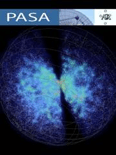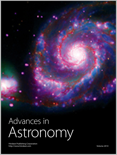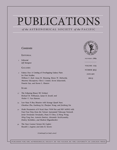
Bulgarian Astronomical Journal
Scope & Guideline
Connecting Researchers to the Wonders of the Universe
Introduction
Aims and Scopes
- Solar and Stellar Dynamics:
Research on solar phenomena, including solar flares, coronal mass ejections, and stellar dynamics, with a focus on their underlying physical mechanisms and interactions. - Astrophysical Modeling:
Development and application of mathematical and computational models to understand complex astrophysical processes such as star formation, dark energy dynamics, and the behavior of celestial objects in various gravitational frameworks. - Photometric and Spectroscopic Observations:
In-depth observational studies using photometric and spectroscopic techniques to analyze the characteristics of stars, binary systems, and transient astronomical events. - Cosmology and Galactic Structure:
Exploration of the large-scale structure of the universe, including studies of galaxy formation, dark matter, and cosmic evolution, often integrating theoretical and observational approaches. - Exoplanetary Science:
Investigation of exoplanets and their environments, focusing on modeling their physical properties and dynamics, as well as observational studies to detect and characterize their atmospheres.
Trending and Emerging
- Dark Energy and Cosmological Models:
An increase in studies related to various models of dark energy, particularly holographic models, suggests a growing interest in understanding the universe's expansion and its implications for cosmology. - Multiscale Astrophysical Theories:
Research on multiscale theories, particularly those involving self-gravitating objects and scalar-tensor theories, is emerging as a significant area of focus, indicating a trend towards integrating complex theoretical frameworks. - Transient Astronomy and Time-Series Analysis:
The analysis of transient events, such as nova eruptions and flickering stars, is gaining traction, highlighting the need for time-series data and its interpretation in understanding stellar behavior. - Astrobiology and Exoplanet Research:
There is a noticeable uptick in studies related to exoplanets, reflecting a broader interest in their characteristics and potential habitability, alongside advancements in observational technologies. - Computational and Data-Driven Astrophysics:
The application of advanced computational techniques and statistical methods, such as fractional order analysis and Kolmogorov-Smirnov tests, is becoming increasingly prevalent, emphasizing a shift towards data-driven research methodologies.
Declining or Waning
- Traditional Stellar Classification:
Research focusing on classical methods of stellar classification has diminished, possibly due to the growing emphasis on more sophisticated models and observational techniques that provide deeper insights into stellar properties. - Solar Cycle Studies:
While solar phenomena remain important, the frequency of studies specifically tied to historical solar cycle patterns appears to be decreasing, suggesting a shift towards more immediate solar events and their impacts. - Astrophysical Fluid Dynamics:
Investigations of fluid dynamics in astrophysical contexts, such as turbulence in molecular clouds, seem to be less prevalent, possibly overshadowed by more pressing topics in dark energy and cosmology. - Historical Astronomical Observations:
There is a noticeable decline in papers focusing on historical data analysis and its implications, indicating a potential shift towards contemporary observational techniques and real-time data.
Similar Journals

Journal of Astronomical History and Heritage
Exploring the Cosmos Through TimeWelcome to the Journal of Astronomical History and Heritage, a distinguished publication that delves into the fascinating intersections between astronomical science and its historical context. Published by University Science & Technology China (USTC), this journal aims to promote a deeper understanding of how humanity's understanding of the cosmos has evolved over time. With a focused scope that encompasses the historical narratives of astronomy, this journal serves as a pivotal resource for researchers, professionals, and students in the fields of Astronomy, Astrophysics, and History. Although it is currently categorized in the fourth quartile for Astronomy and Astrophysics and in the second quartile for History, the journal holds an impressive rank in the arts and humanities category, reflecting its 88th percentile standing. The journal, which has aggregated notable works from 2019 to 2024, represents a unique platform for innovative scholarship and discussions related to our astronomical heritage. While offering limited access options, it strives to contribute significant knowledge to the field, fostering collaboration and exchange among scholars dedicated to understanding the past as we explore the universe.

PUBLICATIONS OF THE ASTRONOMICAL SOCIETY OF AUSTRALIA
Illuminating the Universe Through Scholarly Excellence.Publications of the Astronomical Society of Australia, published by Cambridge University Press, stands as a distinguished platform for advancing knowledge in the realms of Astronomy, Astrophysics, Space, and Planetary Science. Hemmed in the United Kingdom, this journal is recognized for its outstanding contributions, reflected in its status as a Q1 journal in both Astronomy and Astrophysics, along with Space and Planetary Science categories as of 2023. With a solid impact factor, it ranks impressively at #23 within its Scopus category, firmly placing it in the competitive 75th percentile. This publication facilitates open discourse and innovative research from its inception in 1996 to the present year of 2024, providing an essential resource for researchers, professionals, and students eager to deepen their understanding of cosmic phenomena. By embracing rigorous peer-review standards and a commitment to scholarly excellence, the journal not only contributes to the scientific community but also fosters the next generation of astronomical research.

Advances in Astronomy
Bridging Knowledge Gaps in Astronomy and Planetary Sciences.Advances in Astronomy is a prestigious open-access journal published by HINDAWI LTD, dedicated to the field of astronomy and astrophysics. Established in 2008, the journal aims to disseminate significant research findings and advancements in the understanding of celestial phenomena, planetary sciences, and the intricate workings of the universe. With an impact factor that reflects its relevance in the scholarly community, Advances in Astronomy holds a commendable rank of Q3 in both Astronomy and Astrophysics as well as Space and Planetary Science categories, indicating its importance within these fields. The journal also showcases a commitment to open-access publishing, ensuring that research is readily available to both the scientific community and the public. Researchers, professionals, and students alike are encouraged to contribute to this dynamic forum to share knowledge and foster collaboration in exploring the wonders of the cosmos.

PUBLICATIONS OF THE ASTRONOMICAL SOCIETY OF THE PACIFIC
Connecting Researchers to the Stars: Your Essential ResourcePublications of the Astronomical Society of the Pacific is a prestigious journal dedicated to advancing the fields of Astronomy and Astrophysics, as well as Space and Planetary Science. Published by IOP Publishing Ltd, this influential journal plays a critical role in disseminating groundbreaking research and innovative findings. With an impressive Q1 ranking in both related categories according to the 2023 metrics, it is recognized among the top journals in its field. As a vital resource for researchers, professionals, and students alike, the journal covers a range of topics relevant to current astronomical research from 1996 to 2024. Although it does not offer open access options, the journal is highly regarded in academic circles, evidenced by its competitive ranking in Scopus—20th in Astronomy and Astrophysics and 26th in Space and Planetary Science. This commitment to excellence ensures that it remains an essential platform for sharing the latest insights in the ever-evolving universe.

Astrophysical Bulletin
Navigating the Frontiers of Astronomy and AstrophysicsWelcome to the Astrophysical Bulletin, an esteemed journal published by MAIK NAUKA/INTERPERIODICA/SPRINGER that has been contributing to the fields of Astronomy and Astrophysics since its inception in 2009. With a prominent Q3 rating in both Astronomy and Astrophysics and Instrumentation, this journal is designed to foster an understanding of astronomical phenomena through comprehensive research articles and groundbreaking discoveries. While currently not offering open access, it remains a vital resource for researchers and professionals looking to stay informed on the latest advances in the field, featuring a compelling selection of peer-reviewed studies that underscore its relevance and impact. The Astrophysical Bulletin ranks impressively in Scopus, making it a trusted platform for disseminating vital knowledge and new insights into our universe.

Journal of Cosmology and Astroparticle Physics
Exploring the Universe, One Particle at a TimeThe Journal of Cosmology and Astroparticle Physics (ISSN: 1475-7516) is a premier publication in the field of astronomy and astrophysics, dedicated to advancing our understanding of the cosmos through innovative research. Published by IOP Publishing Ltd in the United Kingdom, this journal has established itself as a vital resource for researchers, professionals, and students alike, with an impressive Scopus rank of #11/90, placing it in the top 12% of its field. The journal aims to foster the dissemination of groundbreaking studies related to cosmology, dark energy, particle physics, and the universe's fundamental structure, making it a key player in shaping contemporary astrophysics discourse. With a Category Quartile of Q2 as of 2023, it continues to attract high-quality contributions that enhance scholarly dialogue. As an accessible platform, it engages a diverse audience interested in the frontiers of astrophysical research, encouraging collaboration and knowledge sharing among the global scientific community.

Journal of the Korean Astronomical Society
Elevating Knowledge: Critical Insights from the Astronomical FrontierWelcome to the Journal of the Korean Astronomical Society, an esteemed publication dedicated to advancing the fields of Astronomy and Astrophysics as well as Space and Planetary Science. Established in 1993 and under the reputable auspices of the Korean Astronomical Society, this journal serves as a vital platform for researchers and scholars from South Korea and around the globe to disseminate innovative findings and critical insights. With a commendable Q2 ranking in Astronomy and Astrophysics and a Q3 ranking in Space and Planetary Science, this journal is positioned among the influential voices in its fields, fostering collaboration and knowledge exchange. The journal's rigorous peer-review process ensures that published works contribute significantly to ongoing discussions and developments in astronomical research. While currently not an open-access journal, it remains accessible to the academic community, encouraging readers to stay abreast of the latest advancements in the sciences that elucidate the universe's complexities. Join us in exploring the cosmos through cutting-edge research and scholarly discussion that propels the field forward.

INDIAN JOURNAL OF PHYSICS
Championing Cutting-Edge Research in PhysicsINDIAN JOURNAL OF PHYSICS, published by the Indian Association for Cultivation of Science, serves as a pivotal platform for researchers and scholars in the field of physics and astronomy. With its ISSN 0973-1458 and E-ISSN 0974-9845, this journal is committed to presenting innovative research and developments across diverse topics in physics, covering both theoretical and experimental studies. The journal has made its mark in the academic community, evidenced by its classification in the Q3 category within the Physics and Astronomy domain as of 2023, and ranks #100 out of 243 in the Scopus curated database, placing it in the 59th percentile. Spanning from 2005 to 2024, the INDIAN JOURNAL OF PHYSICS aims to foster knowledge exchange and stimulate discussions among physicists and scientific enthusiasts. Whether you are a researcher looking to publish your findings, a professional seeking updates in your field, or a student eager to explore varying aspects of physics, this journal is an invaluable resource contributing significantly to the understanding and advancement of physics in India and beyond.

Advances in Astronomy and Space Physics
Connecting Ideas, Advancing Knowledge in Space Research.Advances in Astronomy and Space Physics is an esteemed journal dedicated to the exploration and dissemination of research in the expansive fields of astronomy and space science. Published by Taras Shevchenko National University of Kyiv, this journal provides a platform for researchers, professionals, and students to share groundbreaking studies and innovations. With an ISSN of 2227-1481, it covers a wide range of subjects including astrophysics, planetary sciences, and space exploration technologies, thereby fostering interdisciplinary collaboration. Although not an Open Access journal, it maintains a commitment to high-quality, peer-reviewed content that contributes significantly to the advancement of scientific knowledge. The journal's mission is to promote sustainable practices in space research while also exploring the implications of discoveries on Earth and beyond. By maintaining rigorous publication standards, Advances in Astronomy and Space Physics aims to serve as a critical resource for those involved in the ever-evolving study of our universe.

ACTA ASTRONOMICA
Elevating Astronomical Research: Insights from the Heart of the CosmosACTA ASTRONOMICA, the esteemed journal published by the COPERNICUS FOUNDATION POLISH ASTRONOMY, is a pivotal platform for disseminating significant advancements in the fields of Astronomy, Astrophysics, and Space Science. With an established history spanning from 1996 to 2023, this journal maintains a strong position in academia, evidenced by its Q2 ranking in both Astronomy and Astrophysics as well as Space and Planetary Science categories. Targeted at researchers, professionals, and students, ACTA ASTRONOMICA offers a comprehensive collection of articles that foster a deeper understanding of celestial phenomena, planetary exploration, and theoretical advancements in the universe. While it is not an open-access journal, its structured format caters to a global audience eager to engage with cutting-edge research. Notably, its Scopus rankings highlight its relevance, placing it in the 56th percentile for Astronomy and Astrophysics and the 44th percentile for Space and Planetary Science, ensuring that contributors are part of an influential community that is shaping the future of astronomical study.